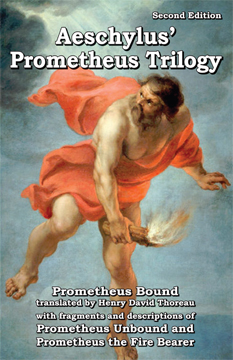
Aeschylus’ Prometheus TrilogyPrometheus Bound translated by Henry David Thoreau
with fragments and descriptions of
Prometheus Unbound and Prometheus the Fire BearerExpanded Second Edition
new material in this edition copyright © 2015, 2019
Read a selection from the bookBuy or preview the book on amazon.comOutside the US, search for this |
Understand the Trilogy
Henry David Thoreau’s translation of Prometheus Bound was published in 1843 in The Dial, the most important magazine of the American transcendentalist movement. This edition makes it available to a wide audience in book form for the first time.
This edition also includes descriptions and fragments of the other two plays of Aeschylus’ Prometheus trilogy.
Prometheus Bound has been one of the most influential of the classical Greek tragedies, inspiring poems by Goethe, Shelly, Byron and others. But it is often misunderstood, because it is read in isolation.
Read by itself, Prometheus Bound seems to tell the story of Prometheus’ heroic resistance to Zeus’ tyranny. But when we read the entire trilogy, we can see that the relation between Zeus and Prometheus is far more complex.
Prometheus Bound has always been considered one of the greatest Greek tragedies - and this book lets us see that the Prometheus trilogy as a whole is more powerful than this one play.
This edition includes an introduction by the great classical scholar, Nikolaus Wecklein, which has long been out of print.
It also includes commentary by Charles Siegel, which makes an important new contribution to scholars’ attempts to reconstruct the Prometheus trilogy.
Aeschylus’ Prometheus Trilogy
Preface by Charles Siegel
Classical tragedies were performed as a competition that lasted three days during the feast of the Great Dionysia. Three playwrights competed, with each presenting three tragedies and one satyr play in a performance that lasted for a day. Often, they wrote trilogies, with the three tragedies telling a continuous story. Only one complete trilogy survives, the Oresteia of Aeschylus, comprising Agamemnon, Libation Bearers, and The Eumenides. This trilogy as a whole is more powerful than the three plays would be individually.
There are also cases where we can reconstruct the trilogy based on fragments of plays that do not survive, on hints in the play that does survive, and on other accounts of the same myths. There are several reasons why it is particularly valuable to publish this reconstruction of the Prometheus trilogy of Aeschylus.
First, reconstructing the trilogy changes our view of its surviving play, Prometheus Bound. Read by itself, as it has been for centuries, Prometheus Bound seems to tell the story of Prometheus’ heroic resistance to Zeus’ tyranny. Reading the entire trilogy, we can see that the relation between Zeus and Prometheus is far more complex.
Second, we have a translation of Prometheus Bound by a great American author. Henry David Thoreau’s translation was published in 1843 in The Dial, the most important magazine of the American Transcendentalist movement. This edition is the first time Thoreau’s translation has been made available to a general audience in book form.
Third, excellent work on reconstructing this trilogy has already been done by a series of classical scholars, ranging from the nineteenth-century German scholar N. Wecklein to the contemporary scholars Mark Griffith and Alan Sommerstein.
There has been a great deal of dispute among scholars about how the trilogy should be reconstructed. Most scholars have concluded that the plays should be in the same order as in this book: Prometheus Bound, Prometheus Unbound, and Prometheus the Fire Bearer. But there has been a wide range of theories, including the suggestion that there was no trilogy, and Prometheus Bound was written by another playwright as a response to Aeschylus’ Prometheus Unbound. The two most authoritative editions both disagree with the order used in this book. Mark Griffith’s edition put the plays in the order Prometheus the Fire Bearer, Prometheus Bound, Prometheus Unbound. Alan Sommerstein’s edition says that Prometheus Bound is followed by Prometheus Unbound, but Prometheus the Fire Bearer cannot possibly go either before or after these two plays.
There is clearly uncertainty involved, but this edition gives a plausible interpretation of the fragments that puts the plays in the order Prometheus Bound, Prometheus Unbound, Prometheus the Fire Bearer and that creates a coherent and dramatically powerful trilogy.
This edition includes an abridged version of Wecklein’s introduction to his book, which provides a thorough account of the history of the Prometheus myth and of the issues involved in reconstructing the trilogy. Because this edition is aimed at the general reader, it includes only fragments that quote from the plays. There are several other fragments that refer to the plays but do not quote from them, which are available in Griffith’s edition.
The Prometheus Satyr Play
Trilogies of Greek tragedy were accompanied by a satyr play, which presented comic action featuring a chorus of satyrs. The satyr play was related to the tragedies, reminding us that these plays were performed at the Dionysia, a festival honoring the god of wine and license.
Aeschylus wrote a satyr play about Prometheus, named Prometheus the Fire Kindler. Plutarch tells us thatThe Satyr, at his first sight of fire, wished to kiss and embrace it, but Prometheus said,
“You, goat, will mourn your vanished beard.”Yet most scholars agree that this satyr play was performed with the trilogy that included Aeschylus’ The Persians, and that it is not connected with the Prometheus trilogy, so it is not included in this book. Nothing is known about the satyr play performed with the Prometheus trilogy.
The Author
From Hellenistic times until the nineteenth century, Prometheus Bound was attributed to Aeschylus, but his authorship is now in doubt because its simple prose style, its short choral lyrics, and the words it uses are different from the six other surviving plays by Aeschylus. In 1857, R. Westphal suggested that the play was originally written by Aeschylus but reworked by another author, and in 1911, A. Gercke was the first to suggest that the play was not written by Aeschylus at all. Mark Griffith wrote a book that describes the controversy at length. He also summarizes the controversy briefly in his edition of Prometheus Bound, and he concludes, “With the limited evidence available to us for comparison (less than one-tenth of Aeschylus’ oeuvre), we cannot hope for certainty one way or the other.”
If the Prometheus trilogy was by another playwright, then he deserves a place alongside the great classical tragedians, Aeschylus, Sophocles, and Euripides. Prometheus Bound has long been considered one of the greatest Greek tragedies and has had a powerful influence on western literature, inspiring poems by Goethe and Byron and a play by Shelly.
Whoever the author is, Prometheus Bound is clearly a great work of literature - and we will see that the Prometheus trilogy as a whole is even more powerful than this one play.
From the Introduction to Prometheus the Fire Bearer
If our reconstruction of Prometheus Unbound is correct and Prometheus was not reconciled with Zeus in this play, then the subject of Prometheus the Fire Bearer must be their reconciliation and Prometheus’ acceptance of his place in the new divine order under the reign of Zeus.
As part of this reconciliation, Prometheus reveals the prophesy about Thetis. Perhaps there is a prophesy of Thetis’ wedding with Peleus and the birth of their child, Achilles.
Aeschylus’ account of how Prometheus accepts his place in the new order would provide an origin myth about the founding of the Athenian festival Prometheia and the altar of Prometheus in the Academy. As Wecklein says in the introduction:
Just outside of Athens was the Kolonos hippos, a hill sacred to Poseidon, which furnished the potters’ quarter of the city, the Kerameikos, with admirable clay for the famous and much-sought Attic vases. Between this hill and the city lay the Academy, the sacred grove of the hero Academus. Here Prometheus was worshipped in conjunction with Hephaestus and Athena. In the space dedicated to the goddess Athena stood an old statue of Prometheus, with an altar. At the entrance was a pedestal with a relief representing Prometheus and Hephaestus. Prometheus was here figured as the more prominent and older god, with a sceptre in his hand; Hephaestus as younger and less important. On the same pedestal a common altar of the two deities was represented. In honor of Prometheus the festival called Prometheia was annually celebrated, with a torch-race from the Academy to the city. The torches were lighted at the altar of Prometheus, and the runners endeavored to outstrip each other without extinguishing their torches.
This is how Prometheus was honored in Athens, as part of a religion that had Zeus at the top of the divine hierarchy, so the ceremony is an apt symbol of the reconciliation of the two and Prometheus’ acceptance of his place in the new order.
The establishment of the altar would also be a fitting conclusion to the trilogy, because it shows Prometheus as more important than Hephaestus—a strong contrast with the beginning of the trilogy, where Hephaestus is binding Prometheus.
The Trilogy
A comparison with Aeschylus’ Oresteia, the one complete trilogy that survives, confirms this view of the Prometheus trilogy. In the first play, Agamemnon, Clytemnestra kills her husband Agamemnon when he returns from the Trojan War. In the second play, Libation Bearers, Agamemnon’s son, Orestes, avenges his father’s murder by killing his mother, but as the play ends, he finds he is pursued by the Eumenides (or Furies), who take revenge on those who kill their parents.
In the third play, The Eumenides, Orestes flees, pursued by the Eumenides, and finally reaches Athens, where he throws himself at the foot of a statue of Athena. Athena creates a jury to try his crime; ultimately, the jury’s vote is tied, which leads to Orestes being acquitted. Athena convinces the Eumenides to accept the verdict and brings them to their new shrine, at the foot of the Areopagus, where they will be honored by the citizens of Athens. The Areopagus was originally a council of elders held on the Hill of Ares and was an important part of the Athenian government, but in Aeschylus’ time, it lost its traditional powers and continued to function as a final court of appeals in murder trials.
Thus, the final play of the Oresteia trilogy explains the origins of three Athenian institutions of Aeschylus’ day: the Athenian law that acquitted defendants if the jury was tied, the function of the Areopagus as the court of appeals in murder trials, and the shrine to the Eumenides at the foot of the Areopagus.
The end of Prometheus Unbound is reminiscent of the end of Libation Bearers. In Libation Bearers, the tension of the first two plays of the trilogy is resolved when Orestes kills his mother, but a new tension is introduced when the Eumenides appear, which will be resolved in the last play of the trilogy. Likewise, in Prometheus Unbound, the tension of the first two plays is resolved when Prometheus is freed, but a new tension has been introduced because Prometheus has said he hates Zeus. This new tension is resolved in the last play of the trilogy, as Prometheus and Zeus are reconciled and Prometheus accepts his place in the new divine order.


